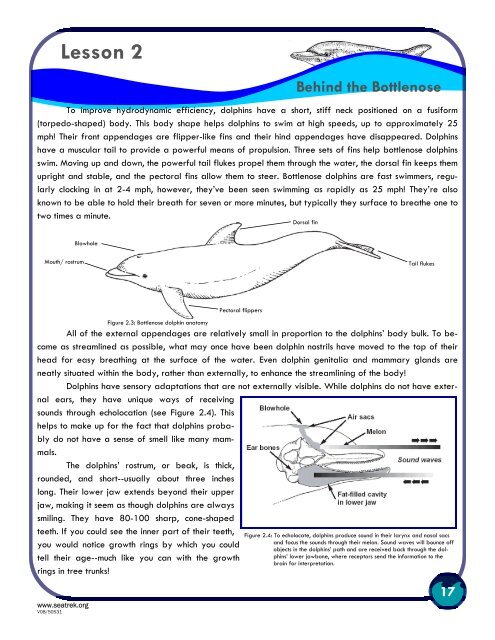LESSON 2 - SeaTrek Programs
LESSON 2 - SeaTrek Programs
LESSON 2 - SeaTrek Programs
Create successful ePaper yourself
Turn your PDF publications into a flip-book with our unique Google optimized e-Paper software.
Lesson 2<br />
Behind the Bottlenose<br />
To improve hydrodynamic efficiency, dolphins have a short, stiff neck positioned on a fusiform<br />
(torpedo-shaped) body. This body shape helps dolphins to swim at high speeds, up to approximately 25<br />
mph! Their front appendages are flipper-like fins and their hind appendages have disappeared. Dolphins<br />
have a muscular tail to provide a powerful means of propulsion. Three sets of fins help bottlenose dolphins<br />
swim. Moving up and down, the powerful tail flukes propel them through the water, the dorsal fin keeps them<br />
upright and stable, and the pectoral fins allow them to steer. Bottlenose dolphins are fast swimmers, regularly<br />
clocking in at 2-4 mph, however, they’ve been seen swimming as rapidly as 25 mph! They’re also<br />
known to be able to hold their breath for seven or more minutes, but typically they surface to breathe one to<br />
two times a minute.<br />
Dorsal fin<br />
Blowhole<br />
Mouth/ rostrum<br />
Tail flukes<br />
www.seatrek.org<br />
V08/50531<br />
Pectoral flippers<br />
Figure 2.3: Bottlenose dolphin anatomy<br />
All of the external appendages are relatively small in proportion to the dolphins’ body bulk. To become<br />
as streamlined as possible, what may once have been dolphin nostrils have moved to the top of their<br />
head for easy breathing at the surface of the water. Even dolphin genitalia and mammary glands are<br />
neatly situated within the body, rather than externally, to enhance the streamlining of the body!<br />
Dolphins have sensory adaptations that are not externally visible. While dolphins do not have external<br />
ears, they have unique ways of receiving<br />
sounds through echolocation (see Figure 2.4). This<br />
helps to make up for the fact that dolphins probably<br />
do not have a sense of smell like many mammals.<br />
The dolphins’ rostrum, or beak, is thick,<br />
rounded, and short--usually about three inches<br />
long. Their lower jaw extends beyond their upper<br />
jaw, making it seem as though dolphins are always<br />
smiling. They have 80-100 sharp, cone-shaped<br />
teeth. If you could see the inner part of their teeth,<br />
you would notice growth rings by which you could<br />
tell their age--much like you can with the growth<br />
rings in tree trunks!<br />
Figure 2.4: To echolocate, dolphins produce sound in their larynx and nasal sacs<br />
and focus the sounds through their melon. Sound waves will bounce off<br />
objects in the dolphins’ path and are received back through the dolphins’<br />
lower jawbone, where receptors send the information to the<br />
brain for interpretation.<br />
17





